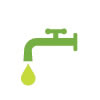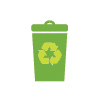More About:
 Water Storage and Transport In general, a water system is composed of four stages: catchment, treatment, storage, and transport. The best local water catchment strategies depend on the source of water available and its ease of extraction and purification. Potable water can be sourced from the ocean, a lake, a river, a spring, rain, a well, air moisture or morning dew (See Water Sources of Tomorrow for details on catchment methods). Without doubt the best quality water is sourced from an artesian mountain spring. However, other sources of water can be treated as described in holistic water treatment to closely meet spring water quality. In most scenarios every home can be equipped with a rain catchment system which can be designed to meet the demands of the residence if no other source is available.
Water Storage and Transport In general, a water system is composed of four stages: catchment, treatment, storage, and transport. The best local water catchment strategies depend on the source of water available and its ease of extraction and purification. Potable water can be sourced from the ocean, a lake, a river, a spring, rain, a well, air moisture or morning dew (See Water Sources of Tomorrow for details on catchment methods). Without doubt the best quality water is sourced from an artesian mountain spring. However, other sources of water can be treated as described in holistic water treatment to closely meet spring water quality. In most scenarios every home can be equipped with a rain catchment system which can be designed to meet the demands of the residence if no other source is available.
The material used to store water is also essential for the quality of water. Ceramics, Stainless steel, copper or stone are all preferable storage containers for water. Furthermore, stagnant water can lose its benefits hence all of Green New World’s storage systems are equipped with a recirculating unit that passes through a hyperbolic chamber to keep the water activated and fresh.
Attention needs to be given to the mode of water transport. The geometry and material of pipes have been shown by Viktor Schauberger and confirmed by other researchers to impact the quality of water. Some materials commonly used are hazardous such as PVC, lead and galvanized steel. Green New World prefers the use of pipes made out of ceramics, stainless steel, copper or natural materials.



